URSA MAJOR (Urban Sustainability in Action: Multi-disciplinary Approach through Jointly Organized Research schools) – integrates research advances and education into a holistic socioenvironmental program for Smart Cities. The project targets future urban stakeholders promoting the Green Deal transformations. It focusses on the regions of amplified climate change where urban areas have urgent needs to improve their sustainability and resilience, and where the cost of maladaptation is intolerably high. The UN Sustainable Development Goal 11 (Sustainable Cities and Communities) is central here.
URSA MAJOR seeks a holistic approach to urban nature-based solutions with strengthening access to digital communication and remote sensing. We provide training in web tools, extended reality, eLearning, FAIR data management, urban modelling, analysis and ethics of societal data. We strive to improve education of civil engineers, ecologists, urban architects, managers, and administrators – all future stakeholders of sustainable and resilient cities.
URSA MAJOR focuses on socio-environmental aspects, which are influential but still strongly underappreciated. URSA MAJOR enhances the qualifying project SERUS introducing a global perspective on the Smart Cities and push for digitalization.
Our consortium is a constellation of complementary partners: NERSC and University of Tromsø provides expertise on integrated urban modeling system and end-user applications; the Norwegian University of Science and Technology (NTNU) links to Smart Cities zero-emission goals and the supporting EU project +CityxChange; SINTEF Digital contributes with digitalization and eLearning; Arctic Frontiers connects with Norwegian stakeholders; Institute of Meteorology and Climatology (IMUK, Germany) provides urban modelling expertise; Nansen Environmental Research Center - India (NERSC) transfers knowledge to the developing world, contributes with remote sensing data analysis; George Washington University (GWU) introduces the social science component; Tyum State University introduces ecosystem components. High quality of research and education is assured by theUniversity in Tromsø, the University in Bergen, and NTNU.
The Nansen Environmental Research Center – India (NERCI) and Nansen Environmental and Remote Sensing Center (NERSC) co-organized a two-day international conference addressing the future energy systems in cities in southern Asia during October 31st and November 1st 2022. The honourable mayor Adv. P. Anilkumar of Kochi Municipality - one of 100 smart cities in India - opened the two day conference on “Powering cities in the global south: How energy access for all benefits the economy and the environment” last week on 31st October 2022. He highlighted the renewable energy achievements in his own city, where Cochin International Airport (CIAL) was the first airport world-wide to be classified as climate neutral, being self-supplied with their energy needs and also the extensive city metro system and recent start on electrification of the numerous autorickshaws operating in the city. He was supportive of the URSA-MAJOR initiatives and efforts that could integrate climate change with the energy issues and energy conservation which lead up to the mayors concluding statement: “Such a conference in our city is an excellent opportunity to get new ideas from experts on how to become a sustainable smart city in all aspects.”
About 20 interesting talks sparked discussions around challenges and opportunities in green energy production and smart energy systems on both national and community levels. The conference was a part of the project URban Sustainability in Action - Multidisciplinary Approach through Jointly Organized Research Schools (URSA-MAJOR) coordinated by the Nansen Center and funded by the Norwegian Research Council through the INTPART program.
Prof. Igor Esau (University of Tromsø and Nansen Center), who initiated URSA MAJOR, held his keynote speech remotely, underlining the need to think untraditionally and “out of the box” to identify regionally adaptable solutions for cities being both consumers and suppliers of energy. Bjørn R. Jacobsen from SINTEF (a URSA-MAJOR partner) gave an overview of the opportunities in visualisation of solutions using VR technology to contribute ease the societal acceptance of new solutions in an urban environment.
Some of the presentations threw light into the situation where Kerala stands with respect to renewable energy concept. More than 90 % of the electricity supply in the State of Kerala comes from hydroelectric power, with presently some minor contributions from other renewable sources such as thermal, solar and wind. During the dry monsoon years there are periodically shortages in the hydropower supply. Increased future supply of electricity is envisaged through development of renewables – mainly solar, wind, green hydrogen production from e.g., water hyacinth plants as well as needs for new capabilities for energy storage.
Scarcity of space is a major limitation in large cities world-wide and much more creative solutions than deployment solar panels along metro lines or covering waters bodies are needed to cater the electricity needs for the future. This was very well demonstrated with many actions from another Indian Smart City - the New Town of Kolkata. Future cities will to a large extent be consumers of energy but will also have potential to generate energy.
Several talks discussed the possibility for India to fulfil its pledges of becoming carbon neutral in 2070, and that this will depend on Europe, US and China reaching their goals for 2050 or 2060. India will then have 10-20 years to capitalize on technology and solutions implemented in other countries, making the Indian goals doable.
After an educating conference and strengthening the collaboration among future stakeholders and managers for sustainable and resilient development of “Smart Cities” in India, project leader Lasse Pettersson reflects: - “The introduced hyacinth plants on the Vembanad Lake causes local problems and we have seen that it can be used to produce biofuel. This usage will free up large waters surfaces that can be covered with floating solar arrays, as were demonstrated from the resort near Trivandrum. This is not a new idea, and the implications of such changes in the environment needs to be carefully assessed both from an ecological and societal point of view.”
The Hon. Minister for Law, Industries and Coir Shri P. Rajeeve from the Government of Kerala concluded the conference, by stating:- “Kerala is a progressive and foreword looking state willing to invest in responsible solutions in our energy supply. We want to strengthen the thigh with Norway in the fields of energy solutions and invites Norwegian industry to take part in this development.”
Around 70 attendees from business, industry, city administration, politicians and scientists from India and Norway were gathered in Kochi, Kerala. The conference was planned and organized by Dr. G. Bindu, director Ajith K. Joseph, and researchers at NERCI. From the Nansen Center in Bergen, director Tore Furevik, research coordinator/senior researcher, leader of URSA-MAJOR and NERCI chairman Lasse H. Pettersson, and researcher Roshin Raj attended the conference.
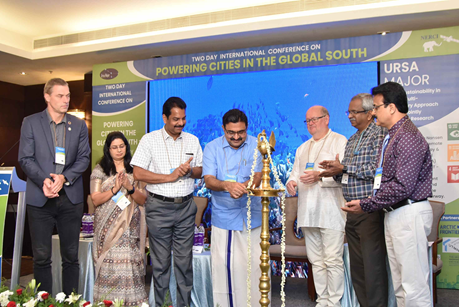
Hon. Mayor Adv. P. Anilkumar inaugurating the conference.

Hon. Minister for Law, Industries and Coir Shri P. Rajeeve at the valedictory sesion
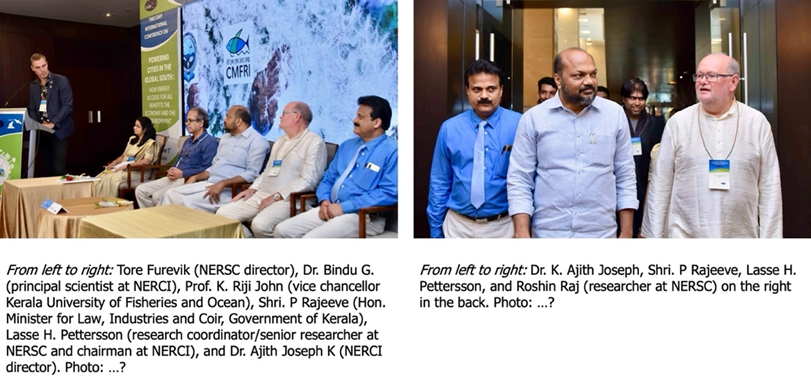
A group from Nansen Environmental Research Centre, India, made a visit to the Energy Observer ship, which is docked at Bolgatti Marina, Kochi, today as part of its world tour. The boat reached Kochi from Langkawi, Indonesia. Owing to the boat's experimental nature, a significant amount of capital had to be spent on its construction, which came to about 50.30 crores in Indian money. The global tour for the French-built boat Energy Observer began in 2017. More than 40 nations have already been visited. Energy Observer is also the first French ambassador of the 17 Sustainable Development Goals presented by the United Nations. The catamaran is designed to prove that entirely decarbonised, decentralised and digitised energy is possible, that such a virtuous circle is achievable. On-board technologies, combining multiple sources- solar, wind and hydropower – and forms of storage, batteries and above all hydrogen, prefigure tomorrow’s intelligent energy networks (smart grid), which can be reproduced on a grand scale.
Energy Observer is a zero-pollution floating laboratory, destined to test an innovative energy architecture in extreme conditions to prove its feasibility onshore. Three renewable energy sources—sun, wind, and hydropower—as well as two different types of storage are included in the energy system (li-ion batteries for the short term and hydrogen for the long term). The Energy Observer is assumed to be the world's first hydrogen-powered boat. The vessel is equipped with complete hydrogen production chain based on sea water electrolysis using a mix of renewable energies. This is known as Green hydrogen. Solar energy cannot be used in locations with limited sunlight. Such situations call for the utilisation of hydrogen electricity.
The 1MWh of electricity produced by the 63kg of hydrogen stored on board the Energy Observer is equal to the typical monthly electricity demand (including electric heating) for a family of four for a period of one month and ten days. The fuel cell produces 1 MWh of electricity from the 63 kg of hydrogen, as well as 1 MWh of thermal energy that may be used for heating and hot water. Two vertical axis wind turbines can produce 2kW of electricity (2 x 1 kW). The wings of wind turbine, with a surface area of 31.5 m² each, are self-supporting and can be rotated 360°. The installation wind turbine on board Energy Observer is a first step in reducing the environmental impact of global shipping. According to simulations carried out on a very large panel of boats, the results are extremely promising: 18 to 42% less energy consumption. This is a significant figure while considering that 90% of world trade is carried by sea. Additionally, it comprises three different types of solar panels that cover a surface area of 130 square metres, producing a peak output of 21 kW. For solar energy, first, bi-facial, heterojunction photovoltaic panels designed by the INES (National Institute of Solar Energy) were used.
Vincent Reynaud, a systems engineer, outlined the boat's intricate operational procedures. Energy Management System (EMS) is the brain of the vessel’s energy supply. Combining multiple intermittent renewable energy sources and storage, optimising their use to propel the boat and ensure the crew’s comfort. It is a set of automated machines which command and coordinate all the systems, and is driven by the human pilots using an on-board computer. On the other hand, strategies are also programmed to recharge batteries and resupply hydrogen stocks whenever possible, to ensure theses reserves are not depleted. For example, when battery life descends below 30%, the majority of the electricity production is used to recharge it. When battery life is over 90%, or the boat is stationary, the energy is used to restore the hydrogen reserves. The pilots can automatically vary the power of the motor, and hence the speed of the boat, to preserve stable charge levels. All these decisions can be managed almost instantly, either by the system, or by the pilots who can take over at any time. This is all by dedicated software comprising 21 SFCs connected to 200 alarms, 12 analogues and 13 digital actuators, 1,050 elements of data can be uploaded by the internal digital network in real time.
Apart from ensuring comfortable navigation for the crew, this data is also a new knowledge base for developing routing software using renewable energy sources and this data can be recovered remotely for preventive maintenance of the whole system. The goal is to test and optimise these technological bricks in order to have them work in harmony and aim towards total energy autonomy.
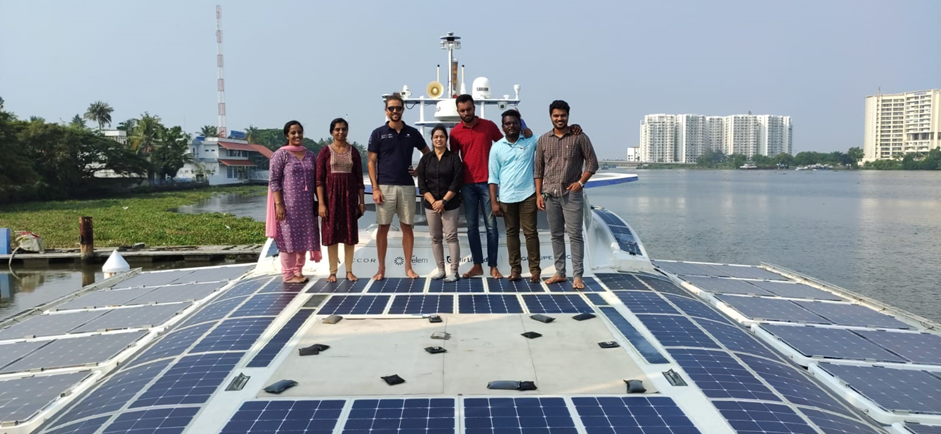
NERCI team at the top of the Energy Observer vessel. Solar panels can be seen attached to the roof.
In December 2022 finalised work plan for internship students which comes under URSA MAJOR activities. Preliminary work started in December itself. The following are the work plans finalised.
Student Name: Abhijith V S, College of Climate Change and Environmental Science (CCCES)
Kerala Agricultural University, Vellanikkara,Thrissur, Kerala – 680656
Student Name: Varghese K P,College of Climate Change and Environmental Science (CCCES),Kerala Agricultural University,
Vellanikkara,Thrissur, Kerala – 680656
An Exploratory Study of Sustainable Urban Transport in Kochi, a Rapidly Developing South Indian Metro City, Using the Sustainable Urban Transport Index (SUTI) and Statistical Analysis.
The present study would help to analysis the sustainability of urban mobility across west and central Kochi based on the Sustainable Urban Transport Index (SUTI) developed by UNESCAP, wherein the following indicators will be analyzed.
Extent to which transport plans cover public transport, intermodal facilities and infrastructure for active Modes, Modal share of active and public transport in commuting, Convenient access to public transport service, Public transport quality and reliability, Traffic fatalities per 100.000 inhabitants, Affordability – travel costs as part of income, Operational costs of the public transport system, Investment in public transportation systems,Air quality (PM10),Greenhouse gas emissions from transport
This attempt is to analyze measure and improve overall sustainability of transport system prevailing in Kochi, in order to encourage and make it easy for stakeholders to discuss their individual performance and drawing implications for urban transport planning.
» The major road networks along with the water and land metro ways in connection with public and active transport hubs will be delineated using remote sensing and GIS technology. Mapping of important tourist, cultural landmarks and trade hotspots, distribution of electric charging stations for both 4 wheeler and two wheelers. Spatio-temporal changes in the mobility networks of the city of Cochin will be analyzed in reference to the road, railway and metro networks.
» Field surveys will be carried out in the areas of west and central Kochi, a representative sample area, to collect informations of indicators for the calculation of SUTI. Primary data for the indicators will be collected through structured and semi-structured interviews with various stakeholders and the general public. In case of limitations of primary data, secondary data will be gathered from peer-reviewed articles, books, internet publications and various websites.
» The ten indicators set will be developed and finalized through collaborative research study and consultative process with city authority, experts, and general public. Equal weight is given to all ten indicators and geometric aggregation is used to derive the Sustainable urban transport index. The linear normalization is done for all the indicators using a 1-100 scale. This will arrive at actual input data and normalized values for 10 indicators for Cochin City. SUTI spider diagram will be generated using normalized minimum and maximum values for stakeholders and look for improvement of indicators with low score .
» Indicator 1: Extent to which transport plans cover public transport, intermodal facilities and infrastructure for active modes
» Indicator 2: Modal share of active and public transport in commuting
» Indicator 3: Convenient access to public transport service
» Indicator 4: Public transport quality and reliability
» Indicator 5: Traffic fatalities per 100.000 inhabitants
» Indicator 6: Affordability – travel costs as part of income
» Indicator 7: Operational costs of the public transport system
» Indicator 8: Investment in public transportation systems
» Indicator 9: Air quality (PM10)
» Indicator 10: Greenhouse gas emissions from transport
For indicator 1, the evaluation of city mobility plan was done by a panel of experts considering the scoring method laid out in the guideline. For indicator 2, available secondary data were used. For indicator 3, the percentage of city population having convenient access to public transport was assessed based on population living within 500 m from a public transport stop with a minimum 20-minutes service. Primary data were collected for indicator 4. Data collected from police and hospital were used for indicator 5. Data for indicator 6 were derived from aggregating monthly transport cost for lower income group. Data for indicator 7 were collected from public transport operators. Data for indicator 8 were collected and derived from city and transport authority. Data for indicator 9 were collected from air quality stations. Data for indicator 10 were derived using top-down and bottom-up approaches.
The main aim of the project is to access the health index of urban ecosystem of Kochi with respect to the past, present, and future land use land cover changes. The Ecosystem Health Condition of Kochi will be analyzed using indicator model, VORS. Land Use Land Cover classification of Kochi using Support Vector Machine (SVM) Classifier and it will be done for 2000,2010 and 2022.The future Land use land cover classification will also be predicted using the CA-ANN model. The sensitivity analysis will also be done using RF and other machine learning algorithms.
From literature review done on the topic it was observed that the implementation of SVM for LULC mapping in developing countries is not yet a widespread. In terms of evaluating the impact of input parameters for CA-ANN models, the employment of machine learning techniques in conjunction with PDF and correlation coefficient is distinctive on its own and the usage of CA-ANN model is also relatively low in developing nations. Reliability of the VORS model can be made much more concrete as the fuzzy logic knowledge is incorporated into the VORS model which improve the results of Ecosystem Health (EH) value obtained. The current study provides a comprehensive examination of past to present LULC mapping and dynamics utilizing cutting-edge methodologies, a novel method for past to present EH circumstances, and uncertainty estimates. It is also one of the few studies that consider various factors at the local scale and provides benchmark references for future urbaneco-environmental planning.
The region of study is the mainland of Kochi, which is found along the 9° 55' 52.4388'' N latitude and 76° 16' 2.2908'' E longitude.
The geographic maps required for the project work will be collected from primary sources and from satellite data like Landsat or Sentinel 2A. The satellite data obtained can be used for mapping the various land use and land cover classes in Kochi.
The LULC of the years 2000,2010,2022 will be analyzed and the future LULC of Kochi will be predicted from the data obtained. The sensitivity analysis of the LULC to various factors will also be determined by various machine learning algorithms.
The present ecosystem health condition of Kochi will be examined through the usage of four indicator models like vigor–organization–resilience–ecosystem service (VORS)
» The land use land cover classification of the desired area can be done through usage of the support vector Machine (SVM) classifier, which is a supervised learning algorithm, for the years 2000,2010 and 2022. The earlier LULC is determined to get an idea of the previous and expected changes to future land use and land cover.
» The prediction of the LULC of the future can be done via the usage of CA-ANN model, the MOLUSCE QGIS plugin will be used to predict future land coverage. The artificial neural network (ANN) method was used in the cellular automata (CA) model because it has been shown to produce better results than other techniques such as linear regression and the usage of CA-ANN model is low in developing countries.
» The sensitivity analysis that comprises of factors that can influence the LULC changes are considered and analyzed to give the impact of each of the factors in influencing the land use and land cover of Kochi. The sensitivity analysis can be carried out by using machine learning algorithms like Random Forest and, Pearson’s coefficient of correlation.
» The assessment of the current health condition of Kochi can be determined with the use of vigor (V), organization (O), resilience (R) and ecosystem services (S) indicators. Each of the indicators have many sub-indicators below them. The weightage of each of the indicator is determined by the contribution of each of the factors to ecosystem degradation. A minimum (min) and maximum (MAX) value will be assigned to each sub-indicators showing the relative quantity to be followed by each for maintaining a healthy ecosystem.
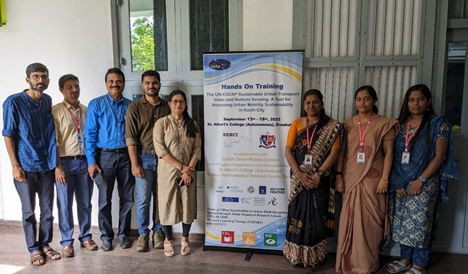
Nansen Environmental Research Centre (India) along with St Albert’s Autonomous College Ernakulam organized a 5-day transformative workshop named “The UN-ESCAP Sustainable Urban Transport Index and Remote Sensing: A Tool for Assessing Urban Mobility Sustainability in Kochi City from 14th -18th September. The primary objective was to empower participants with the knowledge and practical skills necessary to enhance urban mobility sustainability in Kochi City. The comprehensive agenda encompassed various aspects of sustainable urban transport and remote sensing techniques. The workshop commenced with a significant inaugural session that lent an air of importance to the entire event. Director Ajith Joseph K, Bindu G (Principal Scientist), Renith R (Scientist), and the Vice-Principal of St. Albert's College graced this session with their presence. Their attendance underscored the pivotal role of the workshop in advancing urban sustainability in Kochi City.
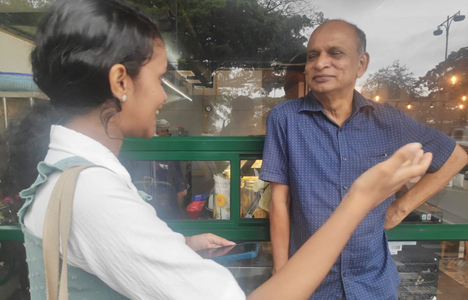
Following the inaugural session, participants dived headfirst into the fundamentals of remote sensing. Under the guidance of Renith R, a highly experienced resource person in GIS, they learned to access satellite data and delved into both foundational and advanced concepts of remote sensing and Geographic Information Systems (GIS). The workshop introduced open data sources and open-source tools, paving the way for hands-on training in spatial data analysis and advanced geo-spatial data analysis methods. The day culminated with a comprehensive introduction to the Sustainable Urban Transport Index (SUTI).

The second day of the workshop was dedicated to practical mapping exercises, reinforcing the participants' understanding of remote sensing and GIS techniques. They diligently mapped critical public transportation areas, road networks, and public spaces/tourist spots. Additionally, participants collaboratively created a boundary map that defined the study area's extent. This day also featured a highly informative field visit to the Cochin Smart Mission Limited (CSML) office, where participants gained invaluable insights into CSML activities and the operations of the Integrated Command and Control Centre (IC4).

The third and fourth days marked the transition from theory to practical fieldwork. Participants conducted field validation activities to ensure the accuracy of the study area maps. They further engaged in transportation opinion surveys spanning Central, North, and South Kochi, actively collecting valuable insights from residents and commuters. Armed with GPS devices, participants meticulously mapped and documented important areas within the study area, adding a layer of precision to their data collection efforts.
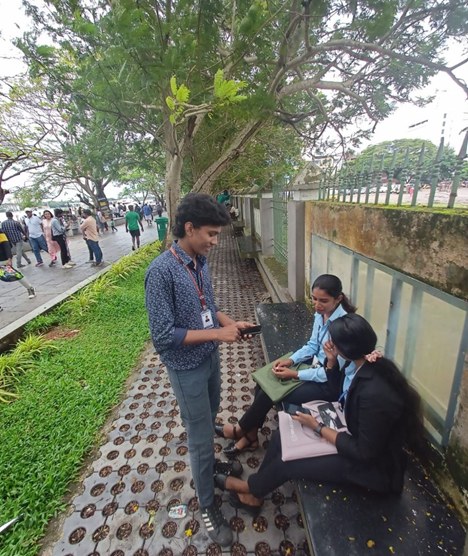
The concluding day of the workshop was a testament to the participants' newly acquired skills and knowledge. They presented their findings and analyses with confidence, showcasing their ability to apply remote sensing and GIS techniques to real-world urban mobility challenges. Certificates were distributed to recognize and celebrate their dedication and contributions to the advancement of sustainable urban transport solutions. `
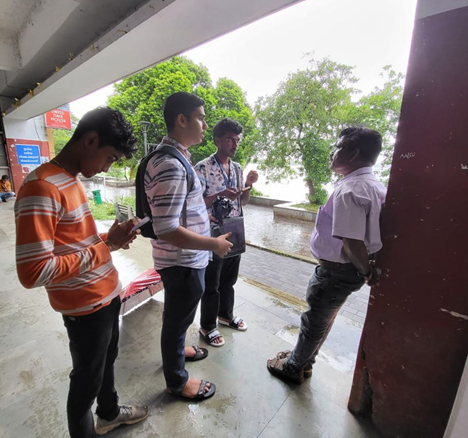
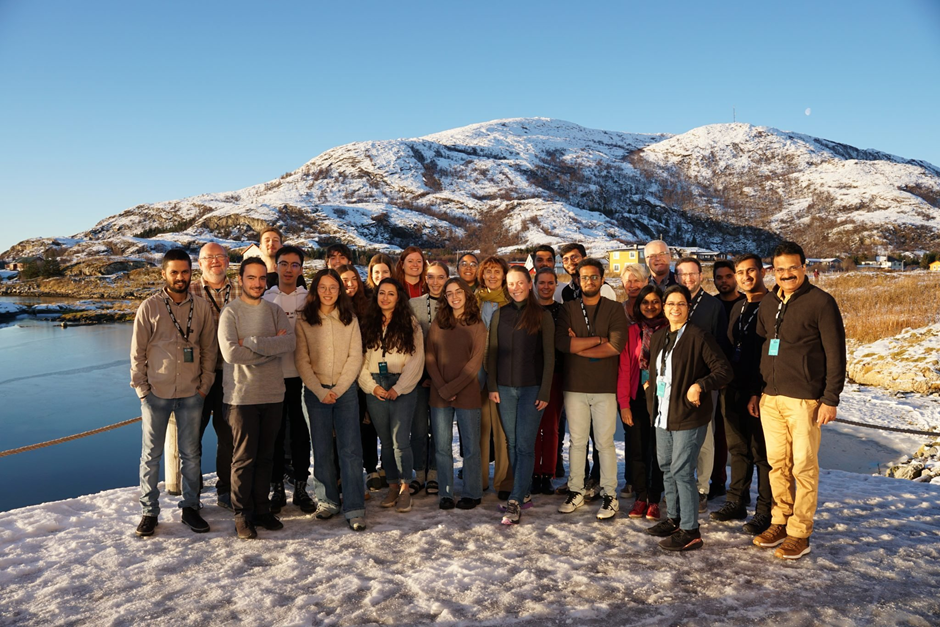
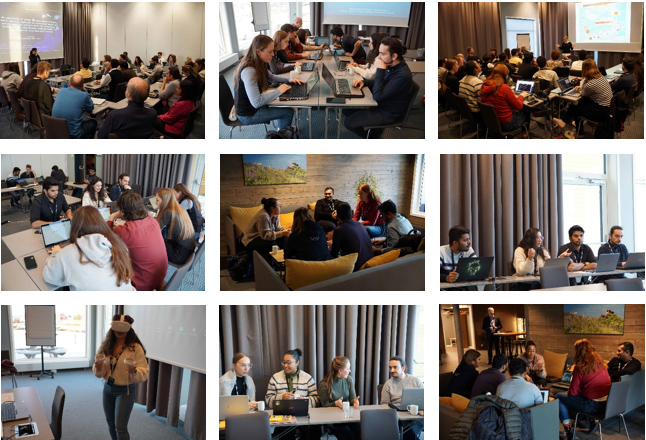
Lasse H. Pettersson Nansen Environmental and Remote Sensing Center (NERSC) Jahnebakken 3 N-5007 Bergen, Norway
lasse.pettersson@nersc.no or nansencentre.india@gmail.com
+47 932 23 563
Nansen Environmental Research
Centere India (NERCI), Kochi
Dr. K. Ajith Joseph
Dr. G. Bindu
ajith_jk@nerci.in, bindupeethu@gmail.com
+91 94471 10832
Powered by Asset Software Solutions